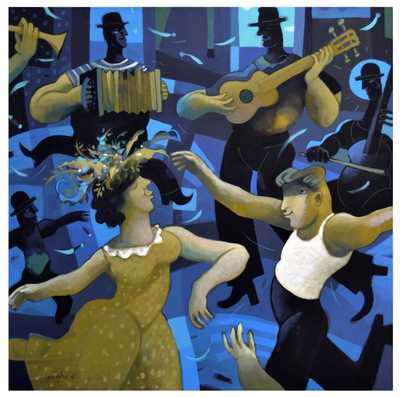We’re happy to feature the work of Alexandrian-born artist Nazir Tanbouli. “The Dancing Canvases“ exhibition opens on 21 of October 2018 at 7 pm and will run until 22 November 2018 at Mashrabia Gallery of Contemporary Art, 8 Champollion st., Downtown Cairo.
Nazir Tanbouli was born in Alexandria in 1971. He started drawing and painting at the tender age of three and since has never stopped. He studied art and design at Alexandria University between 1989 and 1994, and worked as a painter, muralist, illustrator and graphic designer before moving to the UK in 2002 where he has been living since. In 2010 he was awarded the MFA from Camberwell College of Arts, the University of the Arts London, where he studied book art and printmaking.
He was awarded by the same university the “Creative enterprise award 2012” for founding and managing the artist-run space STUDIO 75-London. Since 2015, he has worked frequently in Alexandria.
Tanbouli's work is narrative, biographical, communicative, and often humourous. Both characters and places in his work are a dream-like rendering of all the people he knew and all the places he travelled to. Yet his works often contain many global themes and symbols that make them both non-culturally specific and widely appealing.
He has been exhibiting his work since 1990 in exhibitions in Egypt, UK, USA, Italy, Spain, Russia, Germany, and Dubai. His works are held in many public and private collections around the world.
“Dance is the hidden language of the soul of the body.” Martha Graham
I've never been a good dancer. I'm a left handed painter with two left feet. Nevertheless, I have been fascinated by dancing since my early childhood. I got hooked on dancing films as I grew up in Egypt during the 70s and the 80s.
Then there wasn't much of a dancing culture around me, but I watched all that I could get: old black and white films, the extravaganzas of the 1930s musicals, as well as Fred Astaire, Gene Kelly, West Side Story, and John Travolta in Saturday Night Fever. It was a relationship between the screen and me, trying to desperately copy any of the dance moves while making sure that nobody is watching.
Observing these dances on screen has fuelled my fascination with the ways that the dancers emulate patterns of nature, creating through movement and ever-changing shape an ongoing eternal universe of visio-organic – as simple, yet as complex as the continual splitting of micro-organisms.
Also I have grown to appreciate the decorative, geometric aspect of dancers on the screen, as they sometimes appear like a sheet of patterned textile or the ceiling of an ancient mosque. Many of the paintings in this collection have been painted through my relationship with the movie screen.
The second group of paintings in this collection is highly informed and influenced by my photographic relationship with dance. 17 years ago I moved to multicultural Britain, where every kind of dance was on offer. During my first summer there, I discovered carnivals and street festivals of all sorts: Caribbean in Nottingham, South Asian in Leicester, Brazilian in Liverpool, and Cuban in London.
I wanted to feel close to them but I could not dance. So I took on photography for the first time as it allowed me to get as close as possible to the action, and give me the chance to feel the heat of sweaty dancing bodies. I took hundreds of photographs over the years with no intention to exhibit them or to look at them while painting; their sole function was to allow me to be fearlessly in the middle of the action while seeing it from my camera’s screen.
I want these paintings to be very present, yet I want them to feel like they are seen indirectly, as if through the camera’s eye. I want to keep a visual tension, with the viewer being at the same time engaged with the intense visceral presence of the dance and being isolated from the scene, enjoying the security of a voyeur.
“Work like you don't need the money. Love like you have never been hurt and Dance like nobody's watching.” Satchel Paige, American athlete.
Music and rhythm are essential in my studio, especially while I’m working on this collection of “dancing paintings,” as I want them to be dancing paintings rather than just paintings of dance. I try to establish an input-output process, being more like a dynamo converting dance to painting, while keeping as much as possible of the energy,
Over the years I have accepted the idea that there are always those who dance into a trance and there are those who paint it. I am from the second lot. Yet for eight hours a day in my studio I dance my way back and forth within the three meters between me and my canvas.
These paintings are the closest I could get to dancing while being a left-handed painter with two left feet.
To the magnificent Henri de Toulouse-Lautrec (1864 – 1901)




 RSS Feed
RSS Feed